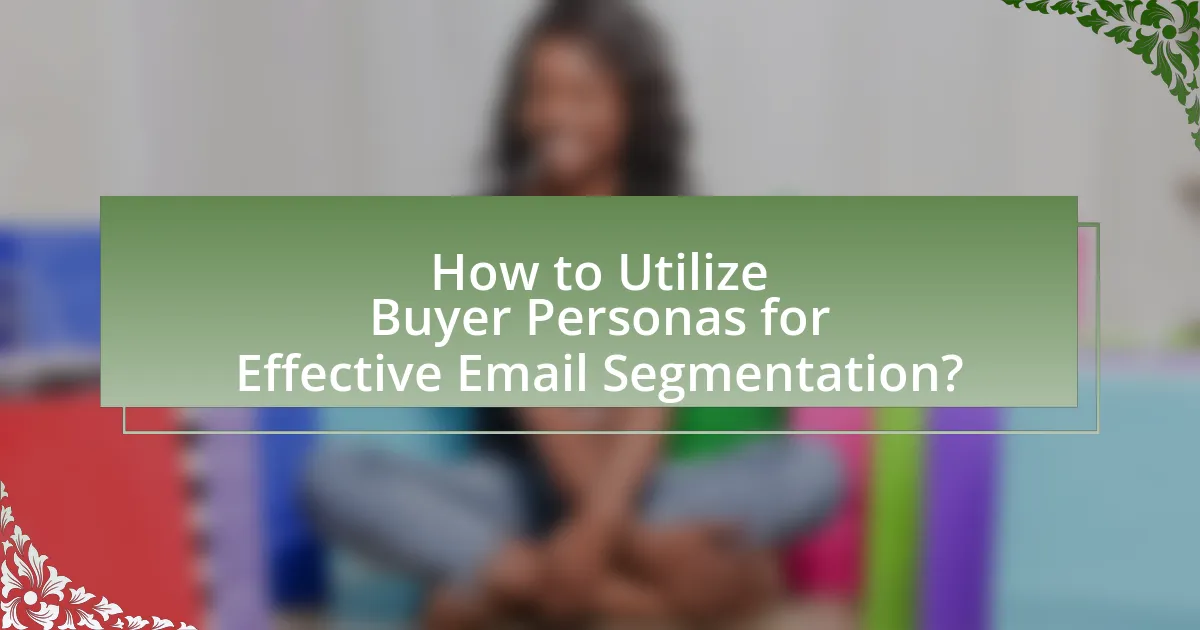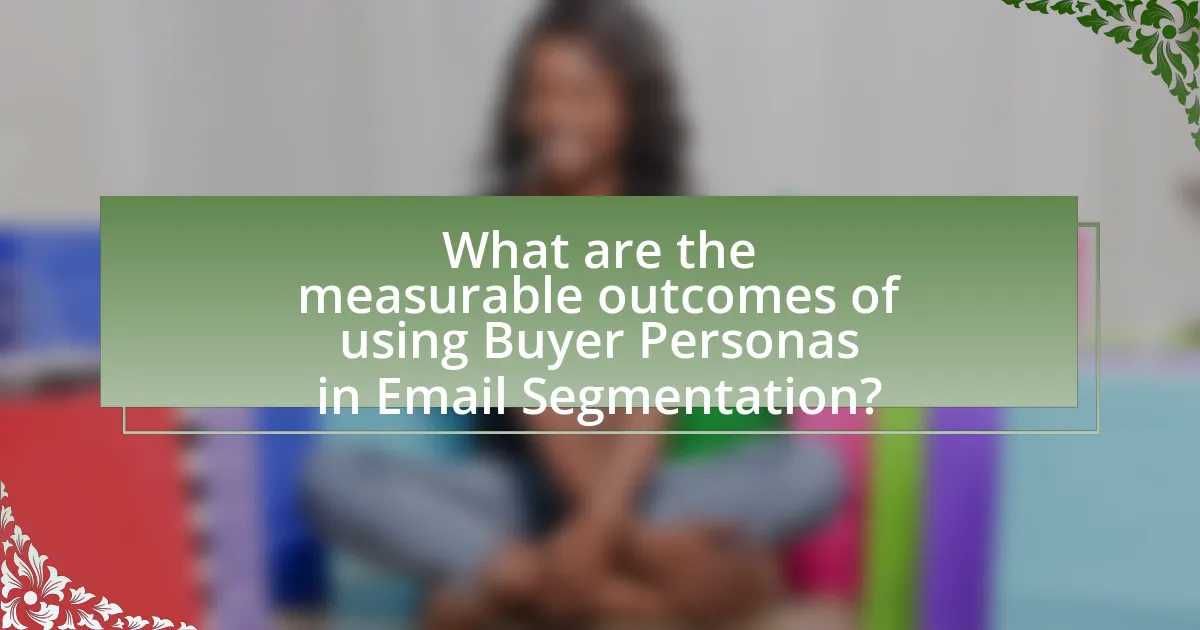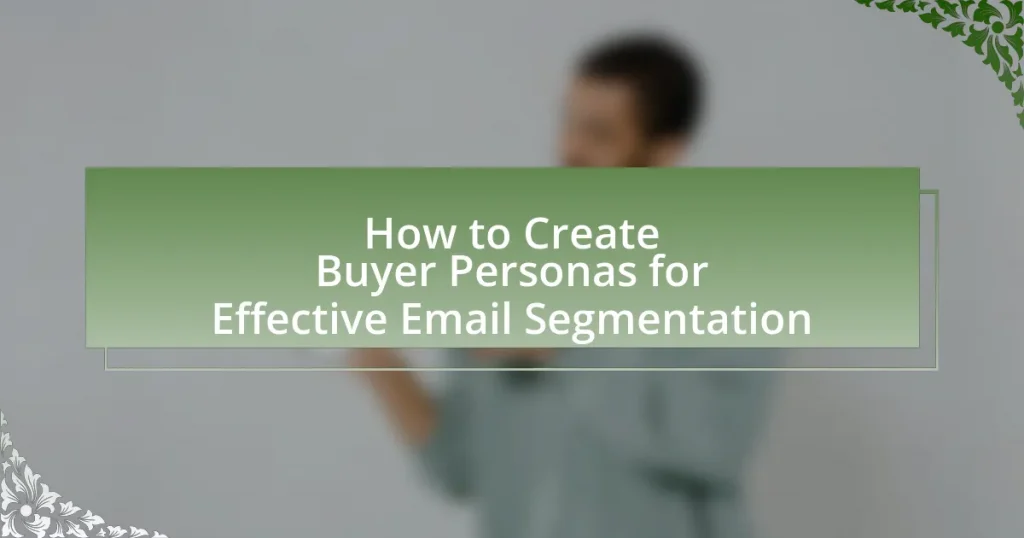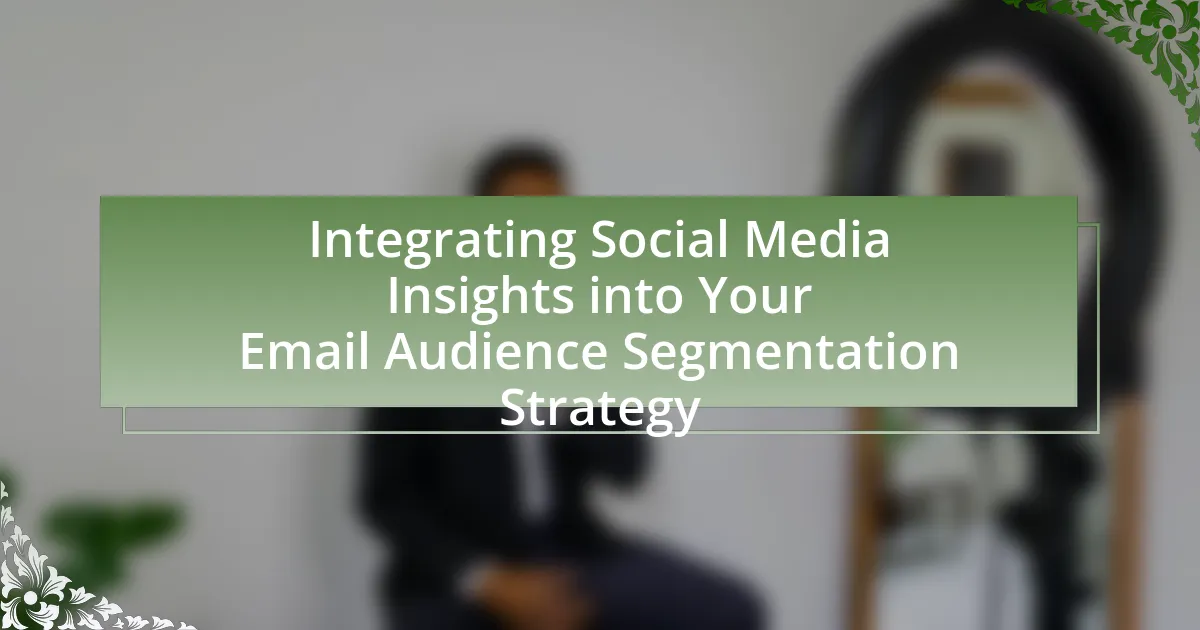Buyer personas are semi-fictional representations of ideal customers, crucial for effective email segmentation. This article outlines the importance of buyer personas in tailoring email content to specific audience segments, enhancing engagement and conversion rates. Key elements defining buyer personas include demographics, behavior patterns, pain points, goals, and purchasing motivations. The article also details steps for creating effective buyer personas, methods for gathering data, and best practices for utilizing them in email marketing strategies. Additionally, it addresses challenges in implementation, data privacy concerns, and the importance of regularly updating personas to maintain relevance and effectiveness in email campaigns.

What are Buyer Personas and Why are They Important for Email Segmentation?
Buyer personas are semi-fictional representations of an ideal customer based on market research and real data about existing customers. They are important for email segmentation because they enable marketers to tailor content and messaging to specific audience segments, increasing engagement and conversion rates. Research indicates that personalized emails can lead to a 29% higher open rate and a 41% higher click-through rate, demonstrating the effectiveness of using buyer personas in email marketing strategies.
How do Buyer Personas influence Email Marketing Strategies?
Buyer personas significantly influence email marketing strategies by enabling marketers to tailor content and messaging to specific audience segments. By understanding the demographics, preferences, and pain points of different buyer personas, marketers can create personalized email campaigns that resonate more effectively with recipients. Research indicates that personalized emails can lead to a 26% increase in open rates and a 760% increase in revenue, demonstrating the impact of targeted messaging. Therefore, utilizing buyer personas allows for more relevant content delivery, ultimately enhancing engagement and conversion rates in email marketing efforts.
What key elements define a Buyer Persona?
A Buyer Persona is defined by key elements such as demographics, behavior patterns, pain points, goals, and purchasing motivations. Demographics include age, gender, income level, and education, which help in understanding the target audience’s background. Behavior patterns encompass how potential customers interact with products or services, including their buying habits and brand loyalty. Pain points identify specific challenges or problems that the persona faces, while goals outline what the persona aims to achieve, guiding marketing strategies. Lastly, purchasing motivations reveal the reasons behind a persona’s buying decisions, which can be influenced by emotional or rational factors. These elements collectively provide a comprehensive view of the target audience, enabling effective email segmentation and tailored marketing efforts.
How can understanding Buyer Personas improve email engagement?
Understanding Buyer Personas can significantly improve email engagement by allowing marketers to tailor content to the specific needs, preferences, and behaviors of their target audience. When marketers create detailed Buyer Personas, they gain insights into what motivates their audience, enabling them to craft personalized messages that resonate more effectively. Research indicates that personalized emails can achieve six times higher transaction rates compared to non-personalized emails, demonstrating the impact of targeted communication on engagement levels. By aligning email content with the interests and pain points of defined Buyer Personas, businesses can enhance open rates, click-through rates, and overall customer satisfaction.
What are the steps to create effective Buyer Personas?
To create effective Buyer Personas, follow these steps: first, conduct thorough research to gather data on your target audience, including demographics, behaviors, and preferences. Next, segment this data into distinct groups based on shared characteristics. Then, develop detailed profiles for each segment, incorporating information such as goals, challenges, and buying motivations. After that, validate these personas through interviews or surveys with actual customers to ensure accuracy. Finally, continuously update and refine the personas based on new insights and market changes. This structured approach ensures that Buyer Personas are relevant and actionable for effective email segmentation.
How do you gather data for creating Buyer Personas?
To gather data for creating Buyer Personas, conduct qualitative and quantitative research through methods such as surveys, interviews, and analyzing customer data. Surveys can provide insights into customer preferences and behaviors, while interviews allow for deeper understanding of motivations and challenges. Analyzing existing customer data, such as purchase history and website interactions, reveals patterns that inform persona development. According to a study by HubSpot, companies that utilize buyer personas see a 73% increase in conversion rates, highlighting the effectiveness of data-driven persona creation.
What methods can be used to analyze customer behavior?
Methods to analyze customer behavior include surveys, web analytics, customer interviews, and social media monitoring. Surveys collect direct feedback from customers about their preferences and experiences, providing quantitative and qualitative data. Web analytics tools, such as Google Analytics, track user interactions on websites, revealing patterns in browsing behavior and conversion rates. Customer interviews offer in-depth insights into individual motivations and pain points, allowing for a deeper understanding of customer needs. Social media monitoring tools analyze customer sentiment and engagement on platforms like Twitter and Facebook, helping businesses gauge public perception and trends. These methods collectively enable businesses to create accurate buyer personas for effective email segmentation.

How to Utilize Buyer Personas for Effective Email Segmentation?
To utilize buyer personas for effective email segmentation, first, define distinct buyer personas based on demographic, psychographic, and behavioral data. This allows marketers to tailor email content to specific audience segments, enhancing engagement and conversion rates. For instance, research by HubSpot indicates that personalized emails can improve click-through rates by 14% and conversion rates by 10%. By aligning email campaigns with the unique needs and preferences of each persona, businesses can deliver relevant content that resonates with recipients, ultimately driving better results.
What are the best practices for segmenting email lists using Buyer Personas?
The best practices for segmenting email lists using Buyer Personas include defining clear personas based on demographic, psychographic, and behavioral data, and tailoring content to meet the specific needs and preferences of each persona. By analyzing customer data, businesses can create distinct segments that reflect the motivations and challenges of their target audience. For instance, a study by HubSpot found that personalized emails based on buyer personas can increase click-through rates by 14% and conversion rates by 10%. This data underscores the effectiveness of using buyer personas for targeted email marketing, leading to improved engagement and higher ROI.
How can you tailor email content to different Buyer Personas?
To tailor email content to different Buyer Personas, segment your audience based on specific characteristics such as demographics, interests, and purchasing behavior. By understanding the unique needs and pain points of each persona, you can craft personalized messages that resonate with them. For instance, a study by HubSpot found that personalized emails can increase click-through rates by 14% and conversion rates by 10%. This data underscores the importance of customization in email marketing, as addressing the specific preferences of each persona leads to higher engagement and effectiveness.
What tools can assist in segmenting email lists based on Buyer Personas?
Tools that can assist in segmenting email lists based on Buyer Personas include HubSpot, Mailchimp, and ActiveCampaign. HubSpot offers advanced segmentation features that allow marketers to categorize contacts based on demographics, behavior, and engagement levels, facilitating targeted email campaigns. Mailchimp provides audience segmentation tools that enable users to create segments based on purchase history and engagement metrics, enhancing personalization. ActiveCampaign combines email marketing with CRM capabilities, allowing for detailed segmentation based on user interactions and preferences. These tools are widely recognized for their effectiveness in improving email marketing strategies through precise audience targeting.
What challenges might arise when implementing Buyer Personas in Email Segmentation?
Implementing Buyer Personas in Email Segmentation can present several challenges, including data accuracy, persona development complexity, and audience diversity. Data accuracy issues arise when the information used to create personas is outdated or incomplete, leading to ineffective targeting. The complexity of developing accurate personas can hinder the segmentation process, as it requires in-depth research and analysis of customer behavior and preferences. Additionally, audience diversity poses a challenge, as a single persona may not adequately represent the varied interests and needs of a broader customer base, resulting in generalized messaging that fails to resonate with specific segments. These challenges can ultimately impact the effectiveness of email campaigns and reduce engagement rates.
How can you overcome data privacy concerns when collecting persona information?
To overcome data privacy concerns when collecting personal information, implement transparent data collection practices and obtain explicit consent from users. Transparency involves clearly communicating what data is being collected, how it will be used, and who it will be shared with, which builds trust with users. Obtaining explicit consent ensures that individuals are aware of and agree to the data collection, aligning with regulations such as the General Data Protection Regulation (GDPR) that mandates informed consent for personal data processing. Additionally, employing data anonymization techniques can further protect user identities while still allowing for effective persona creation.
What strategies can help in maintaining updated Buyer Personas?
To maintain updated Buyer Personas, regularly collect and analyze customer data through surveys, interviews, and analytics tools. This ongoing data collection allows businesses to identify shifts in customer behavior, preferences, and demographics. For instance, a study by HubSpot found that companies that update their Buyer Personas regularly see a 10% increase in customer engagement. Additionally, integrating feedback from sales and customer service teams can provide insights into evolving customer needs, ensuring that Buyer Personas remain relevant and actionable.

What are the measurable outcomes of using Buyer Personas in Email Segmentation?
The measurable outcomes of using Buyer Personas in Email Segmentation include increased open rates, higher click-through rates, improved conversion rates, and enhanced customer engagement. Research indicates that personalized email campaigns, which leverage Buyer Personas, can achieve open rates that are 29% higher and click-through rates that are 41% higher compared to non-segmented campaigns. Additionally, companies that utilize Buyer Personas in their email marketing strategies report conversion rates that are up to 6 times higher. These metrics demonstrate the effectiveness of targeted messaging based on Buyer Personas, leading to more relevant content and stronger connections with the audience.
How can you track the effectiveness of email campaigns targeted at specific Buyer Personas?
To track the effectiveness of email campaigns targeted at specific Buyer Personas, utilize metrics such as open rates, click-through rates (CTR), conversion rates, and engagement levels. These metrics provide insights into how well the content resonates with each persona. For instance, a study by Mailchimp indicates that segmented campaigns can lead to a 14.31% higher open rate compared to non-segmented campaigns, demonstrating the importance of targeting. Additionally, analyzing A/B testing results can help refine messaging and design tailored to each persona’s preferences, further enhancing campaign effectiveness.
What metrics should be monitored to evaluate success?
To evaluate success in creating buyer personas for effective email segmentation, key metrics to monitor include open rates, click-through rates (CTR), conversion rates, and unsubscribe rates. Open rates indicate the effectiveness of subject lines and audience targeting, while CTR measures engagement with the email content. Conversion rates reflect the percentage of recipients who take the desired action, such as making a purchase, demonstrating the effectiveness of the segmentation strategy. Unsubscribe rates provide insight into audience satisfaction and relevance of the content. Monitoring these metrics allows for data-driven adjustments to improve email marketing strategies and enhance overall effectiveness.
How can feedback from email campaigns inform future Buyer Persona development?
Feedback from email campaigns can significantly inform future Buyer Persona development by providing insights into customer preferences, behaviors, and engagement levels. Analyzing metrics such as open rates, click-through rates, and conversion rates reveals which segments of the audience respond positively to specific content or offers. For instance, if a particular demographic shows higher engagement with personalized subject lines, this indicates a preference for tailored communication, which can be integrated into the Buyer Persona. Furthermore, qualitative feedback from customer responses or surveys linked to email campaigns can highlight pain points and motivations, allowing marketers to refine their personas based on real customer data. This data-driven approach ensures that Buyer Personas evolve in alignment with actual customer behavior, enhancing the effectiveness of future email segmentation strategies.
What are some practical tips for creating and using Buyer Personas effectively?
To create and use Buyer Personas effectively, start by conducting thorough research to gather data on your target audience, including demographics, behaviors, and pain points. This data can be collected through surveys, interviews, and analytics tools, which provide insights into customer preferences and motivations. Next, segment your audience into distinct personas based on shared characteristics, ensuring that each persona represents a specific segment of your market.
Once the personas are defined, use them to tailor your email marketing strategies, crafting personalized messages that resonate with each persona’s needs and interests. For instance, a study by HubSpot found that personalized emails can increase click-through rates by 14% and conversion rates by 10%. Regularly review and update your personas based on new data and feedback to keep them relevant and effective in guiding your marketing efforts.
How often should Buyer Personas be reviewed and updated?
Buyer Personas should be reviewed and updated at least annually. Regular reviews ensure that the personas reflect current market trends, customer behaviors, and changes in business strategy. According to a study by HubSpot, 70% of marketers who regularly update their buyer personas report improved marketing effectiveness, indicating that frequent updates align marketing efforts with evolving customer needs.
What common mistakes should be avoided when creating Buyer Personas?
Common mistakes to avoid when creating Buyer Personas include relying on assumptions instead of data, failing to segment personas accurately, and neglecting to update personas regularly. Relying on assumptions can lead to inaccurate representations of target customers, as evidenced by a study from HubSpot which found that 70% of marketers who used data-driven personas saw improved engagement. Failing to segment personas accurately can result in ineffective targeting, as different segments may have distinct needs and behaviors. Neglecting to update personas can cause businesses to miss shifts in customer preferences, which research from the Content Marketing Institute indicates can lead to a 30% decrease in marketing effectiveness over time.




